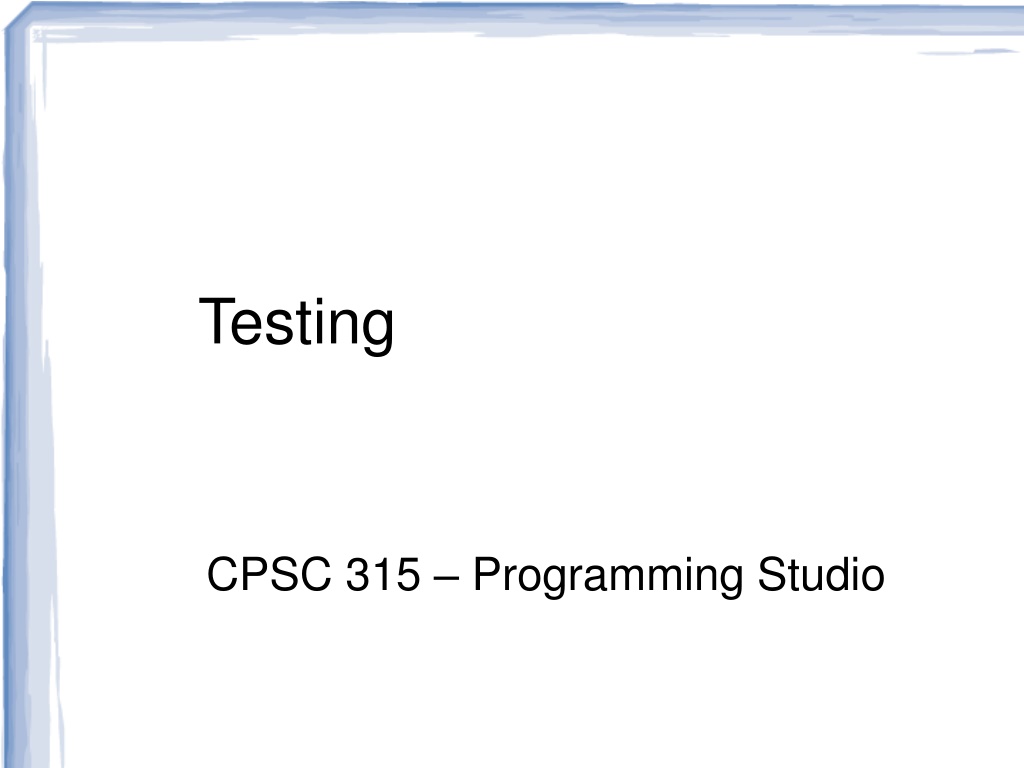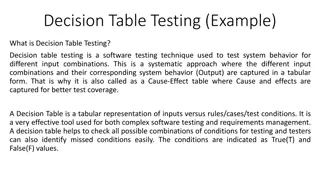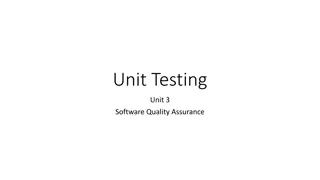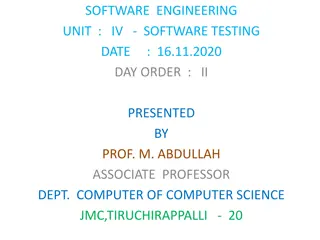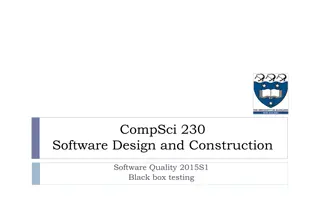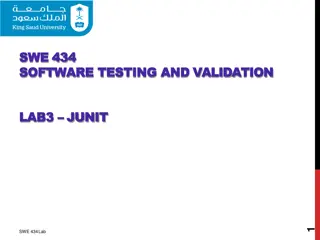Understanding Software Testing and Best Practices
Explore the various aspects of software testing, including types of testing like unit, integration, regression, and system testing. Learn about the importance of writing test cases early, testing as you write code, and boundary testing to enhance software quality. Discover the significance of developer tests and how they contribute to improving software reliability and performance.
Uploaded on Sep 24, 2024 | 0 Views
Download Presentation

Please find below an Image/Link to download the presentation.
The content on the website is provided AS IS for your information and personal use only. It may not be sold, licensed, or shared on other websites without obtaining consent from the author. Download presentation by click this link. If you encounter any issues during the download, it is possible that the publisher has removed the file from their server.
E N D
Presentation Transcript
Testing CPSC 315 Programming Studio
Testing Testing helps find that errors exist Debugging finds and fixes them Systematic attempt to break a program that is working Unlike all other parts of software development, whose goal is to avoid errors Can never prove absence of errors Testing alone does not improve quality
Types of Testing Unit testing Testing of a single class, routine, program Usually single programmer Testing in isolation from system Component testing Testing of a class, package, program Usually small team of programmers Integration testing Combined test of two or more classes, packages, components, or subsystems
Types of Testing (continued) Regression testing Repetition of previously tested cases to find new errors introduced System testing Executing software in final configuration, including integration with all other systems and hardware Security, performance, resource loss, timing issues
Other Testing Usually by specialized test personnel User tests Performance tests Configuration tests Usability tests Etc. We re interested in developer tests
Writing Test Cases First Helps identify errors more quickly Doesn t take any more effort than writing tests later Requires thinking about requirements and design before writing code Shows problems with requirements sooner (can t write code without good requirements)
Testing As You Write Code Boundary Testing Pre- and Post-conditions Assertions Defensive Programming Error Returns Waiting until later means you have to relearn code Fixes will be less thorough and more fragile
Boundary Testing Most bugs occur at boundaries If it works at and near boundaries, it likely works elsewhere Check loop and conditional bounds when written Check that extreme cases are handled e.g. Full array, Empty array, One element array Usually should check value and +/- 1 Mental test better than none at all
Preconditions and Postconditions Verify that routine starts with correct preconditions and produces correct postconditions Check to make sure preconditions met Handle failures cleanly Verify that postconditions are met No inconsistencies created Need to define pre-/postconditions clearly Provable software relies on this approach
Assertions Available in C/C++ assert.h Way of checking for pre-/postconditions Helps identify where problem occurs Before the assertion e.g. usually in calling routine, not callee Problem: causes abort So, useful for testing for errors
Defensive Programming Add code to handle the can t happen cases Program protects itself from bad data
Error Returns Good API and routine design includes error codes Need to be checked
Systematic Testing Test of complete code pieces Test incrementally Test simple parts first Know what output to expect Verify conservation properties Compare independent implementations Measure test coverage
Test Incrementally Don t wait until everything is finished before test Test components, not just system Test components individually before connecting them
Test Simple Parts First Test most basic, simplest features Finds the easy bugs (and usually most important) first
Know What Output To Expect Design test cases that you will know the answer to! Make hand-checks convenient Not always easy to do e.g. compilers, numerical programs, graphics
Verify Conservation Properties Specific results may not be easily verifiable Have to write the program to compute the answer to compare to But, often we have known output properties related to input e.g. #Start + #Insert - #Delete = #Final Can verify these properties even without verifying larger result
Compare Independent Implementations Multiple implementations to compute same data should agree Useful for testing tricky code, e.g. to increase performance Write a slow, brute-force routine Compare the results to the new, elegant routine If two routines communicate (or are inverses), different people writing them helps find errors Only errors will be from consistent misinterpretation of description
Measure Test Coverage What portion of code base is actually tested? Techniques to work toward this Following slides Tend to work well on only small/moderate code pieces For large software, tools help judge coverage
Logic Coverage Or, Code Coverage Testing every branch, every path through the code Can grow (nearly) exponentially with number of choices/branches Only suitable for small to medium size codes
Structured Basis Testing Testing every line in a program Ensure that every statement gets tested Need to test each part of a logical statement Far fewer cases than logic coverage But, also not as thorough Goal is to minimize total number of test cases One test case can test several statements
Structured Basis Testing (continued) Start with base case where all Boolean conditions are true Design test case for that situation Each branch, loop, case statement increases minimum number of test cases by 1 One more test case per variation, to test the code for that variation
Data Flow Testing Examines data rather than control Data in one of three states Defined Initialized but not used Used In computation or as argument Killed Undefined in some way Variables related to routines Entered Routine starts just before variable is acted upon Exited Routine ends immediately after variable is acted upon
Data Flow Testing (continued) First, check for any anomalous data sequences Defined-defined Defined-exited Defined-killed Entered-killed Entered-used Killed-killed Killed-used Used-defined Often can indicate a serious problem in code design After that check, write test cases
Data Flow Testing (continued) Write test cases to examine all defined- used paths Usually requires More cases than structured basis testing Fewer cases than logic coverage
Example if (cond1) { x = a; } else { x = b; } if (cond2) { y = x+1; } else { y = x+2; } if (cond3) { z = c; } else { z = d; } Logic Coverage / Code Coverage Conditions: T T T Conditions: T T F Conditions: T F T Conditions: T F F Conditions: F T T Conditions: F T F Conditions: F F T Conditions: F F F Tests all possible paths 1. 2. 3. 4. 5. 6. 7. 8.
Example if (cond1) { x = a; } else { x = b; } if (cond2) { y = x+1; } else { y = x+2; } if (cond3) { z = c; } else { z = d; } Structured Basis Testing 1. Conditions: T T T 2. Conditions: F F F Tests all lines of code
Example if (cond1) { x = a; } else { x = b; } if (cond2) { y = x+1; } else { y = x+2; } if (cond3) { z = c; } else { z = d; } Data Flow Testing Conditions: T T T Conditions: T F F Conditions: F T ? Conditions: F F ? Tests all defined-used paths Note: cond3 is independent of first two 1. 2. 3. 4.
Example if (cond1) { x = a; } else { x = b; } if (cond2) { y = x+1; } else { y = x+2; } if (cond3) { z = c; } else { z = d; } Data Flow Testing Conditions: T T T Conditions: T F F Conditions: F T ? Conditions: F F ? Tests all defined-used paths Note: cond3 is independent of first two 1. 2. 3. 4.
Example if (cond1) { x = a; } else { x = b; } if (cond2) { y = x+1; } else { y = x+2; } if (cond3) { z = c; } else { z = d; } Data Flow Testing Conditions: T T T Conditions: T F F Conditions: F T ? Conditions: F F ? Tests all defined-used paths Note: cond3 is independent of first two 1. 2. 3. 4.
Example if (cond1) { x = a; } else { x = b; } if (cond2) { y = x+1; } else { y = x+2; } if (cond3) { z = c; } else { z = d; } Data Flow Testing Conditions: T T T Conditions: T F F Conditions: F T ? Conditions: F F ? Tests all defined-used paths Note: cond3 is independent of first two 1. 2. 3. 4.
Test Case Design (If you don t know the code) Boundary analysis still applies Equivalence partitioning Don t create multiple tests to do the same thing Bad data Too much/little Wrong kind/size Uninitialized Good data Minimum/maximum normal configuration Middle of the Road data Compatibility with old data
Test Automation Should do lots of tests, and by-hand is not usually appropriate Scripts can automatically run test cases, report on errors in output But, we need to be able to analyze output automatically Can t always simulate good input (e.g. interactive programs) People cannot be expected to remain sharp over many tests Automation reduces workload on programmer, remains available in the future
Regression Testing Goal: Find anything that got broken by fixing something else Save test cases, and correct results With any modifications, run new code against all old test cases Add new test cases as appropriate
Test Support Tools Test Scaffold Framework to provide just enough support and interface to test Stub Routines and Test Harness Test Data Generators System Perturber
Stub Routines Dummy object/routine that doesn t provide full functionality, but pretends to do something when called Return control immediately Burn cycles to simulate time spent Print diagnostic messages Return standard answer Get input interactively rather than computed Could be working but slow or less accurate
Test Harness Calls the routine being tested Fixed set of inputs Interactive inputs to test Command line arguments File-based input Predefined input set Can run multiple iterations
Test Data Generators Can generate far more data than by hand Can test far wider range of inputs Can detect major errors/crashes easily Need to know answer to test correctness Useful for inverse processes e.g. encrypt/decrypt Should weight toward realistic cases
System Perturbers Modify system so as to avoid problems that are difficult to test otherwise Reinitialize memory to something other than 0 Find problems not caught because memory is usually null Rearrange memory locations Find problems where out-of-range queries go to a consistent place in other tests Memory bounds checking Memory/system failure simulation
Other Testing Tools Diff tools Compare output files for differences Coverage monitors Determine which parts of code tested Data recorder/loggers Log events to files, save state information Error databases Keep track of what s been found, and rates of errors Symbolic debuggers Will discuss debugging later, but useful for tests
